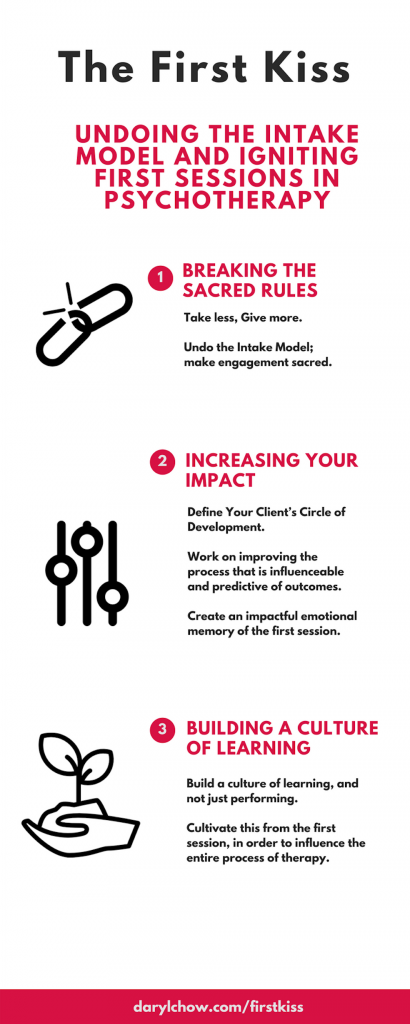Over the next few blogs, I will share with you excerpts from the book, The First Kiss: Undoing the Intake Model… Each chapter is to the point.
This book will be in ebook and paperback formats. Release date: 4th of July 2018.
Chapter 1. Intake Second (Not First)
The Intake Model tells us to conduct a thorough clinical assessment before we begin to “intervene.” We were taught to find out as much about a client’s presenting problem, their family background, psychiatric history, etc. As logical as the Intake Model may seem, when the first session is oriented towards only getting information about our client, we lose our clients in the first session. Your client leaves feeling unhelped.
I propose a different perspective. An Engagement Model.1
Simply stated, an Engagement Model focuses on the degree the client actively participants in the treatment process. In order for this to happen, we first need to create a climate of emotional safety. This is vital to promoting a holding environment that facilitates growth and igniting hope in our clients from the first session. An Engagement Model says that while it is necessary to know our clients first, it is not necessary to know everything about our client. In fact, we may even have some background information missing at the end of the first session. An Engagement Model prescribes that assessment and interventions are ongoing. A good first session is more about what you suspend doing, than what you actually did.
While the Intake Model values information, the Engagement Model prioritises connection.
The former is interested in what information the therapist needs, and the latter focuses on what the client needs. The Engagement Model sees that one of the most important things in the first session is to lay the groundwork that facilitates deep engagement,2 and not over-emphasise getting a thorough intake.
An Engagement Model holds dear the lingering questions in our client’s mind: “Can you relate? Can you appreciate the depths of my suffering? Do you understand me at a deep level?” As Carl Rogers says, “when a person realizes he has been deeply heard, his eyes moisten. I think in some real sense he is weeping for joy. It is as though he were saying, ‘Thank God, somebody heard me. Someone knows what it’s like to be me.’”3
For clients to be seen earlier by a therapist, an agency decided to employ a triage officer. Based on an Intake Model, this meant that they would dedicate a trainee psychologist to conduct an intake session, and then farm the client out to a psychologist to conduct the therapy. By the way, the client would also have to pay a full fee for the intake interview, making the finance department rather pleased with this new process. This is a broken system. It might look sensible from a macro perspective, but makes no sense if you were the person in need of help.4
We are taught to begin with the end with mind. We should still think ahead. However, it would be a detriment to believe that, “Once we’ve conducted a good psychological assessment and create a good case formulation, we can work through the many layers of the psyche and get to the core stuff.” If we fail to engage in the first session, our client might not see a future working with us.
Begin with the beginning in mind. Keep first things first. This helps to keep the first session focused.
For those who want to geek out, an extensive footnote is provided for each chapter in the book.
Footnotes:
1 A word of caution. I am aware that the use of the word model to a bunch psychotherapists is dangerous. I do not mean a school of therapy. All I am suggesting is a different framework to approach and organise our ways of thinking.
For a thorough review of the operational definition of client engagement, check out
Holdsworth, E., Bowen, E., Brown, S., & Howat, D. (2014). Client engagement in psychotherapeutic treatment and associations with client characteristics, therapist characteristics, and treatment factors. Clinical Psychology Review, 34(5), 428-450. doi:http://dx.doi.org/10.1016/j.cpr.2014.06.004
2 This echoes Carl Rogers unforgettable words: “In my early professional years I was asking the question: How can I treat, or cure, or change this person? Now I would phrase the question in this way: How can I provide a relationship which this person may use for his own personal growth?” (p.32)
Rogers, C. (1961). On Becoming a Person. New York: Houghton Mifflin Company.
3 Rogers, C. R. (1980). A way of being. New York: Houghton Mifflin Company.
4 Nielsen, S. L., Okiishi, J., Nielsen, D. L., Hawkins, E. J., Harmon, C. S., Pedersen, T., . . . Jackson, A. P. (2009). Termination, Appointment Use, and Outcome Patterns Associated With Intake Therapist Discontinuity. Professional Psychology Research & Practice June, 40(3), 272-278.




What a relief to read this Daryl. Enter the human being! Thank you.
Thanks Rob. (Or enter the fish! We evolved from fish, according to ichthyologist Prosanta Chakrabarty)